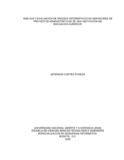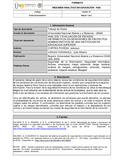Mostrar el registro sencillo del ítem
ANÁLISIS Y EVALUACIÓN DE RIESGOS INFORMÁTICOS EN SERVIDORES DE PROYECTOS ADMINISTRATIVOS DE UNA INSTITUCIÓN DE EDUCACIÓN SUPERIOR
| dc.contributor.advisor | Carrol Vargas, Joel | |
| dc.coverage.spatial | cead_-_josé_acevedo_y_gómez | spa |
| dc.creator | Cortes Poveda, Jeferson | |
| dc.date.accessioned | 2020-08-05T15:34:39Z | |
| dc.date.available | 2020-08-05T15:34:39Z | |
| dc.date.created | 2020-07-30 | |
| dc.identifier.uri | https://repository.unad.edu.co/handle/10596/35721 | |
| dc.description | RAE | |
| dc.description.abstract | Los ataques informáticos se están convirtiendo en un reto y un punto muy importante a revisar profundamente en las grandes empresas ya que las pérdidas que se han generado a partir de estos son muy grandes. Así mismo, las instituciones de educación superior deben tener en cuenta este aspecto en sus modelos tecnológicos, tanto de infraestructura como aplicaciones y sistemas de información, debido al gran volumen de información de usuarios que manejan constantemente. El presente trabajo de grado tiene como objetivo revisar las condiciones de seguridad informática de los servidores de una institución de educación superior, revisión que comprende la evaluación de riesgos desde lo físico hasta lo más intangible como lo son aplicaciones y sistemas de información. Para la revisión de la seguridad informática de los servidores se utiliza la metodología Magerit la cual comienza con la descripción de los activos de la empresa, que en este caso se limita a los servidores y los sistemas de información que gestionan la información de los usuarios. Una vez identificados los activos, se detectaron las amenazas que puede afectarlos, se plantea la probabilidad de ocurrencia de estas amenazas sobre los activos y se mide el impacto de los riesgos sobre los activos. A continuación, se determinan los posibles controles que se sugieren aplicar a los riesgos identificados, controles que reducen el impacto y la degradación de los activos y al mismo tiempo aumentan los niveles de seguridad de la información de la institución. Esta evaluación se apoya con la herramienta EAR/PILAR la cual incorpora toda la metodología Magerit y cada una de sus fases, partiendo de la gestión de los activos para posteriormente llegar a la identificación los riesgos y la proposición de los controles. Con la metodología Magerit y la herramienta EAR/PILAR se logró mostrar y evidenciar los niveles de riesgo antes y después de aplicar los controles propuestos y se pudo contrastar el riesgo e impacto potencial y el riesgo e impacto residual que se hallaron en la revisión. | spa |
| dc.format | ||
| dc.title | ANÁLISIS Y EVALUACIÓN DE RIESGOS INFORMÁTICOS EN SERVIDORES DE PROYECTOS ADMINISTRATIVOS DE UNA INSTITUCIÓN DE EDUCACIÓN SUPERIOR | |
| dc.type | Proyecto aplicado | |
| dc.subject.keywords | Seguridad de la Información, Seguridad informática, Activos, amenazas, riesgo potencial, riesgo residual, análisis de riesgos, salvaguardas, controles, impacto potencial, impacto residual, Margerit | spa |
| dc.description.abstractenglish | Computer attacks are becoming a challenge and a very important point to review deeply in large companies since the losses that have been generated from these are very large. Likewise, higher education institutions must take this aspect into account in their technological models, both of infrastructure and applications and information systems, due to the large volume of information from users that they constantly handle. The purpose of this work is to review the computer security conditions of the servers of a higher education institution, a review that includes the assessment of risks from the physical to the most intangible, such as applications and information systems. The Magerit methodology is used to review the computer security of the servers, which begins with the description of the company’s assets, which in this case is limited to the servers and information systems that manage user information. Once the assets have been identified, the threats that may affect them are detected, the probability of occurrence of these threats on the assets is considered, and the impact of the risks on the assets is measured. Thus, the possible controls that are suggested to be applied to the identified risks are determined; controls that can reduce the impact and degradation of assets and at the same time increase the security levels of the institution’s information. This evaluation is supported by the EAR / PILAR tool which incorporates all the Magerit methodology and each of its phases, based on the management of the assets to subsequently identify risks and propose controls.. With the Magerit methodology and the EAR / PILAR tool, it was possible to show and demonstrate the risk levels before and after applying the proposed controls and it was possible to contrast the risk and potential impact and the risk and residual impact found in the review. | spa |
| dc.subject.category | Seguridad Informática | spa |
| dc.subject.category | Gestión de riesgos | spa |
Ficheros en el ítem
Este ítem aparece en la(s) siguiente(s) colección(ones)
-
Seguridad informática [631]
















